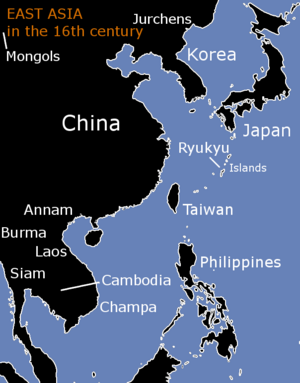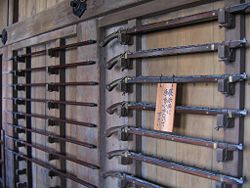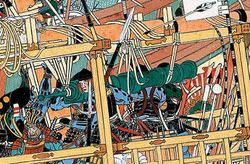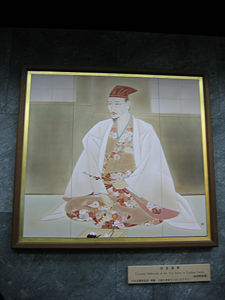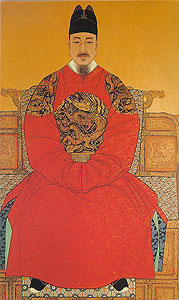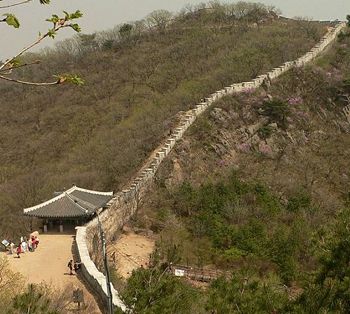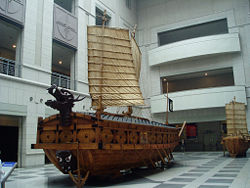Korean War of 1592-1598: Difference between revisions
imported>Chunbum Park |
imported>Chunbum Park |
||
| Line 60: | Line 60: | ||
Toyotomi Hideyoshi succeeded in pacifying Japan through his conquests. Warlords no longer wasted men and resource in the endless feuds, but united behind Hideyoshi for the single goal of unification and the promise of more lands. But Hideyoshi realized that he would inevitably run out of new lands to conquer in Japan. The idle warlords would again engage in internal power struggles, unity would disappear, and Hideyoshi would lose power. Thus, even before he unified all of Japan, Hideyoshi looked outward to keep his military machine running. Hideyoshi said in 1585, "I am going to not only unify Japan but also enter Ming China."<ref name="hawley21-2">Hawley, 2005. pp. 21-2</ref> | Toyotomi Hideyoshi succeeded in pacifying Japan through his conquests. Warlords no longer wasted men and resource in the endless feuds, but united behind Hideyoshi for the single goal of unification and the promise of more lands. But Hideyoshi realized that he would inevitably run out of new lands to conquer in Japan. The idle warlords would again engage in internal power struggles, unity would disappear, and Hideyoshi would lose power. Thus, even before he unified all of Japan, Hideyoshi looked outward to keep his military machine running. Hideyoshi said in 1585, "I am going to not only unify Japan but also enter Ming China."<ref name="hawley21-2">Hawley, 2005. pp. 21-2</ref> | ||
Hideyoshi had pretty good reasons to believe that China could be conquered within his lifetime. First, Hideyoshi observed that the the Chinese were unable to protect the seas against the Chinese and Japanese pirates. Second, Hideyoshi believed that China's lack of interest in keeping Japan within the tributary system also indicated Ming's weakness because, as a military dictator himself, Hideyoshi could not imagine otherwise.<ref name="hawley23-5">Hawley, 2005. pp. 23-5</ref> Third, Hideyoshi gathered clear evidence of Korea's | Hideyoshi had pretty good reasons to believe that China could be conquered within his lifetime. First, Hideyoshi observed that the the Chinese were unable to protect the seas against the Chinese and Japanese pirates. Second, Hideyoshi believed that China's lack of interest in keeping Japan within the tributary system also indicated Ming's weakness because, as a military dictator himself, Hideyoshi could not imagine otherwise.<ref name="hawley23-5">Hawley, 2005. pp. 23-5</ref> Third, Hideyoshi gathered clear evidence of Korea's weakness when in 1587 he sent 26 ships to the southern parts of the peninsula to test the defenses.<ref name="swope21"> Swope, 2005. pp. 21</ref> Hideyoshi believed that he could blitzkrieg across the Korean peninsula toward Beijing and drive the entire tributary system into his hands.<ref name="hawley23-5"/> | ||
In his past winning experiences, Hideyoshi offered his enemy a chance to surrender before engaging in battle, and Hideyoshi planned to bestow that same benevolence to Korea. It was simply a logical response that Hideyoshi developed to his successive repeats of complete annihilation for his opponents, and it worked for most of the time in Japan. Hideyoshi seemed pretty positive that the wise Koreans would also surrender to his threats of invasion. | In his past winning experiences, Hideyoshi offered his enemy a chance to surrender before engaging in battle, and Hideyoshi planned to bestow that same benevolence to Korea. It was simply a logical response that Hideyoshi developed to his successive repeats of complete annihilation for his opponents, and it worked for most of the time in Japan. Hideyoshi seemed pretty positive that the wise Koreans would also surrender to his threats of invasion. | ||
Revision as of 21:54, 27 January 2008
The Japanese invasions of Korea (1592-1598) comprised a major war between Japan and the alliance of Ming of China and Joseon of Korea. Japan invaded Korea on May 23, with the larger objective to conquer the entirety of Asia (and the whole world)[1] by using Korea as a land bridge to China. The battles that involved 300,000 combatants and claimed more than 2 million lives took place almost entirely on the Korean peninsula and its nearby waters. The war consisted of two main invasions from Japan – the first in 1592 and 1593, and the second from 1597 to 1598.
Toyotomi Hideyoshi, the predominant warlord in Japan, had for long been aspiring to leave his name in history as a great conqueror of Asia. Even before unifying all of Japan in 1590, Hideyoshi began sending ambassadorial missions in 1587 to Korea to invite Korea to submit and join with Japan on war against China. However, most of his message failed to go through to the Korean side, since Hideyoshi relied on the Tsushima Island as his main diplomatic channel to Korea, and his subjects there benefited only from a peaceful trade relation with Korea. The Koreans sent a friendly embassy to Japan, but Hideyoshi mistook the mission as Korea's gesture of surrender. The Korean embassy returned with a letter directly from Hideyoshi, that clearly revealed his hostile intentions. The Korean court wrote to Hideyoshi that he was foolishly mistaken, and again Hideyoshi tried to persuade the Koreans to surrender, until just before his forces were ready. Hideyoshi launched the invasion late in May of 1592 and commanded his forces in absentia.
The Japanese troops first attacked the southeastern part of Korea and then advanced northwestward to the capital. The Korean capital city of Hanseong fell within 3 weeks and most of the peninsula came into Japanese control by the end of the year. China responded by sending 5,000 troops to the city of Pyeongyang in late August, but the Chinese were horribly outnumbered and defeated by the Japanese troops. However, within a few days of the Chinese defeat, the Korean admiral Yi Sun-sin annihilated the Japanese fleet carrying the reserve troops that would continue the invasion into China. On January 1, 1593, the Chinese launched a counter-offensive with 30,000 troops and reclaimed Hanseong by the middle of May. With the southeastern parts of the peninsula in Japanese possession, the two sides spent several years in diplomatic talks; the Japanese officials justified their invasion by asserting that Korea carried out policies to prevent Japan from entering the Chinese tributary system. Consequently the Chinese diplomats went to Japan and invested Hideyoshi, whose subordinates misled him into believing that the Chinese had come to surrender in person. The peace negotiations culminated in another invasion of Korea by the Japanese troops in October of 1597 when Hideyoshi found out the truth behind the Chinese visit and felt greatly offended. Hideyoshi's forces saw very little success and, as ordered by Hideyoshi, began to withdraw late in 1598.[2] The war ended middle in December with the naval battle at the straits of Noryang, where the Korean and the Chinese fleets sunk over 300 Japanese ships costing as many as 10,000 lives.
The war is known by several English titles, including the Hideyoshi's invasions of Korea, in context of Hideyoshi’s biography; the Seven Year War, in reference to the war’s duration (the fighting continued even during the peace negotiations); and the Imjin War, in reference to the war's first year in the sexagenery cycle (in Korean).[3] The Koreans call the war "the bandit invasion of the year Imjin (water dragon)". The various Japanese titles include the "Korean War", and the "Pottery War" and "War of Celadon and Metal Type" (in reference to the booties that the returning Japanese soldiers brought home from the war). The Chinese use "the Korean Campaign" to refer to the war.[1]
Template:Collapsible Info Table on Article Titles
Background reading
East Asia and the Chinese Tributary System
The war took place within the context of the Chinese tributary system that dominated the East Asian geopolitics. In practice, the tributary states periodically sent ambassadors to the Chinese imperial court to pay homage and to exchange gifts, while maintaining complete autonomy. Many of the tributary states received from China the rights toward the international trade within the tributary system. The theoretical justification for the tributary system was the doctrine of the Mandate of Heaven, that the Heaven granted the Chinese Emperor the exclusive right to rule, with the purpose of benefiting the entirety of mankind.[4] Several Asian countries, including Korea,[5][6] voluntarily joined the tributary system in pursuit of the legal tally trade and the legitimacy in their rule through the doctrine of the Mandate of Heaven.
An 1870 map of China, Korea, and Japan.
Japan actively sought to engage in the tributary trade and attained from China the two treaties, in 1404 and in 1434, that admitted Japan into the tributary system and required Japan to police its waters against the wako pirates. However, as the Japanese lords failed to effectively control its piracy, China expelled Japan from the tributary system in 1547.[7] The trade issue would emerge again, during the wartime negotiations between Japan and China, as a cautious excuse from the Japanese to justify their first invasion of Korea.
China came to Korea's aid during the war mainly because of Korea's symbolic importance to the Chinese. The Chinese and Koreans considered themselves as the pinnacles of civilization, similarly to today's cross-national cultural identities (such as "the West") based on scientific and academic achievements.[8] The very strict Confucian ideologies that imbued the two countries contributed to this elitism by rejecting the foreign customs and learnings as immoral and barbaric. Additionally, China had to fulfill its promise to provide security to its tributary states. The Chinese authorities feared greatly that the China's loss of legitimacy on this occasion would spur a domino effect of opposition, collapsing the entire tributary system.[9] If not, still the loss of Korea to Japan meant that China could no longer outflank the northern region of Manchuria, in its war against the hostile Jurchen tribes.[10]
Military situations of Japan, Korea, and China
This conflict played out to be one of the earliest cases of modern warfare in Asia. The Sino-Korean alliance and the Japanese deployed several hundreds of thousands of troops across the peninsula in a constant exchange of technological innovations and strategic adaptations. Superior technology of the Sino-Korean militaries heavily contributed to the Japanese retreat from the peninsula by 1598.[11]
An illustrative example of the war's modern attributes is the participants' extensive use of the European firearms. While primitive firearms had seen a limited but continual production in China (for 200 years) and a temporary development in Korea, the advanced muskets that would be used in the war were first introduced in 1543 to Japan by the Portuguese traders on the island of Tanegashima.
The Portuguese arquebus deeply impressed the Japanese, who had experienced by then more than a century of civil war. Within few years of its introduction, several hundred tanegashima (as they were first called)[12] were locally produced in Japan, and, by 1556, 300,000 guns existed in Japan.[13] The new weapon was much more affordable than the bow and arrows because the round lead-bullets were cheaper to produce than the crafted arrows, and skilled archers were rare and expensive while any men could be trained as gunners under cheap pay. The arquebus had a range of nearly half a kilometer and a penetrating power strong enough to pierce iron armor at close range.[14] The Japanese observed several inconveniences with the new long-ranged weapon, including the slow loading time between each shot and its poor accuracy. A warlord named Oda Nobunaga overcame the deficiencies by arranging his men to fire their guns in concentrated volleys, and conquered with success a third of Japan before his assassination in 1582. Toyotomi Hideyoshi, one of Nobunaga's followers who came out to be successful in the ensuing power struggle, continued Nobunaga's conquest up to the unification of Japan in 1590.
By the end of civil war in Japan, Hideyoshi had built up an army of 500,000 veteran troops. The army consisted mostly of infantry and partly of cavalry, and the infantry further divided into archers, spearmen, and gunners. The flawed, conventional view of the war in brief is that the Japanese, armed with superior weapons (mainly the muskets), were winning the war until Admiral Yi developed the iron-clad turtle ships, and the Chinese joined the Koreans to simply outnumber the Japanese. There are several reasons why this perspective became dominant. First the Japanese chroniclers who worked for the Japanese commanders often exaggerated the accomplishments of their employers and inflated the number of enemies. Second, in Korea and China, the established historiographical practices limited the historians to a framework of praise and blame in their analysis, and made inevitable their emphasis on the military weakness of Sino-Korean alliance. And third, these early misinterpretations provided a firm basis for the later scholars to continue the myth of Japanese victory.[15]
In fact, the Korean troops were, on the most part, very poorly organized, equipped, and trained. The 200 years of relative peace in Korea necessitated the Joseon government to keep only a few active military units. In contrast to the Japanese chain of command, the higher-ups of the Korean military tended to consist of officers with political connections more than individuals of merit. Several scholar officials within the king's court attempted to push military reforms, such as a nationwide increase of regular troops to 100,000 and an implementation of the matchlock guns brought as a gift by a Japanese ambassador (see below); however, such voices were lost in the constant political battles waged by the two dominant factions within the king's court. Thus the Joseon military could deploy only a total of 84,500 troops throughout the first invasion[16] against the Japanese sum of 200,000[17] (initial force of 150,000 plus reinforcements).
On the other hand, Korea was ahead of Japan in many of the military technologies. Since the late 14th century, the Koreans developed gunpowder weapons based on existing models in China and went beyond to experiment with originals and hybrids. From China, the Koreans borrowed designs of the European-derived cannons and the rockets originating in China. The local inventions included the anti-ship wooden missiles that could be fired from cannons for kinetic impact, and wooden carts that could launch multiple pellets per fire, including the rocket-propelled arrows and small-sized cannon balls. The Koreans developed a few more weapons just before the war, including the iron-clad turtle ship (completed after the war's start) and the delayed-action explosive iron shells, an explosive that could fly 500 paces from a mortar and "roll" some more distance after hitting the ground.[18] The Koreans, already experienced in the manufacture of the more advanced cannons, immediately began manufacturing match-lock guns on the event of the war; however, the Japanese never caught up to the allies' superior artillery technologies all throughout the war.
Explanation on why a fore-and-aft sail is better than a square sail. Click on this image for further details. Note that a fore-and-aft sail can rotate while a square sail cannot.
The Japanese were also behind in shipbuilding. While the Koreans dedicated their naval ships as warships, the Japanese wanted their ships mainly as transports for their troops, and built them lightly for maximum speed and minimum production cost. The Japanese assembled their ships with iron nails that would corrode in water and degrade the wood; on the other hand, the Koreans put their ships together with bamboo that expanded and stiffened in water. Thus, the Korean ships were much more stronger structurally than the nailed up Japanese ships that loosened over time. Several more shipbuilding techniques that the Koreans accumulated over the years happened to be superior to the Japanese equivalents. For example, the Japanese and the Chinese adopted "V"-shaped hulls to increase speed of their vessels, but the Koreans had to build their ships on rectangular bottoms so that, during low tide, they may "sit" on sand.[19] The underwater geography around the Korean peninsula was flat, and the Korean coastlines experienced fast tides that vacillated over a huge littoral span. The boxy design reduced the speed of the Korean ships but fared much better than the "V"-shaped hull in terms of stability and maneuverability. Another example was the Japanese' frequent use of the single, square sails that were useless without good winds and offered less maneuverability than the fore and aft sails of the Chinese and the Korean ships. Finally, all these disadvantages prevented the Japanese from installing more and bigger cannons on their vessels as the Chinese and the Koreans.[20] The ships were too light and fragile and could not withstand the impact of their own cannons well. On that account, several Japanese drawings depicting the naval engagements during the war show that, in some instance, the Japanese suspended their larger cannons with ropes to prevent damage on their ships.[21]
Thus, the Japanese were successful in the early parts of the war not because their technologies were superior but because the troops were experienced, well-equipped, and far more numerous than the Koreans. Even if one were to consider the very start of the invasion, when only the Japanese soldiers used muskets, the Japanese guns with a maximum range of 600 yards did not completely outdate the Koreans' composite-reflex bows with a similar limit of 500 yards (the Japanese bows had a range of 350 yards).[22] Later in the war, the Koreans could manufacture both the artillery weapons and the arquebuses, but the Koreans did not deploy them to the extent that the Japanese did with their arquebuses. Instead, the Korean soldiers usually fought with spears, swords, bows and arrows, or a combination of such traditional weapons.[23] With the exception of the officers, most Korean soldiers lacked armor and dressed in cotton; the Japanese infantry wore armors consisting of a metal breastplate and extensions of hard, lacquered leather. It is worth mentioning that one area where the Japanese had a clear lead over the Koreans and the Chinese was the manufacture of lighter and sharper swords.[24]
When the Chinese joined the Koreans, they poured advanced machines into the conflict in a full scale that the Koreans could not achieve, and countered the multitude of Japanese muskets with a handful of their heavier cannons.[25] Technology then tied the war and eventually gave way to victory for the allies. The Chinese deployed no more than 80,000 soldiers during any stage of the war, and, on most occasions, the combined allies maintained only a slight advantage over the Japanese in number. Close examinations of the primary sources reveal that the Japanese disliked risking in full-scale fighting with the Chinese because of their superior military machines, not their numerical advantage.[26] Some very interesting weapons in the Chinese arsenal included the crossbows,[22] smoke bombs, hand grenades, battering rams loaded with gunpowder,[27] bulletproof armor,[28] and mortars that fired up to 100 missiles per discharge.[29]
Pre-War embassies and preparations
Toyotomi Hideyoshi succeeded in pacifying Japan through his conquests. Warlords no longer wasted men and resource in the endless feuds, but united behind Hideyoshi for the single goal of unification and the promise of more lands. But Hideyoshi realized that he would inevitably run out of new lands to conquer in Japan. The idle warlords would again engage in internal power struggles, unity would disappear, and Hideyoshi would lose power. Thus, even before he unified all of Japan, Hideyoshi looked outward to keep his military machine running. Hideyoshi said in 1585, "I am going to not only unify Japan but also enter Ming China."[30]
Hideyoshi had pretty good reasons to believe that China could be conquered within his lifetime. First, Hideyoshi observed that the the Chinese were unable to protect the seas against the Chinese and Japanese pirates. Second, Hideyoshi believed that China's lack of interest in keeping Japan within the tributary system also indicated Ming's weakness because, as a military dictator himself, Hideyoshi could not imagine otherwise.[31] Third, Hideyoshi gathered clear evidence of Korea's weakness when in 1587 he sent 26 ships to the southern parts of the peninsula to test the defenses.[32] Hideyoshi believed that he could blitzkrieg across the Korean peninsula toward Beijing and drive the entire tributary system into his hands.[31]
In his past winning experiences, Hideyoshi offered his enemy a chance to surrender before engaging in battle, and Hideyoshi planned to bestow that same benevolence to Korea. It was simply a logical response that Hideyoshi developed to his successive repeats of complete annihilation for his opponents, and it worked for most of the time in Japan. Hideyoshi seemed pretty positive that the wise Koreans would also surrender to his threats of invasion.
But there was no way that the Koreans would take Hideyoshi seriously. Not only were the Koreans unaware of the recent developments in Japan, as Hideyoshi knew little of the outside world, but the Koreans already had a long-established idea of where Japan stood in the world order. The Chinese and the Koreans saw the Japanese as arrogant dwarfs, and to civilize them was beyond any hope. Again and again, the Koreans would find the Japanese behaviors to be rude and contrary to the Chinese practices. For example, the Japanese would surprisingly refer to their powerless emperor with the Chinese character reserved solely for the Chinese Emperor, the son of Heaven.[33] The Koreans also found Japan's status as a country to be questionable, since the emperor was simply a figurehead and his subjects with actual power always waged wars amongst themselves.
Hideyoshi ordered So Yoshishige, the daimyo of the Tsushima Island, to carry out the diplomacy with the Koreans. Since all trade and diplomatic ships between Japan and Korea had to pass through the "Tsushima gate", So was very well aware of the Korean situation and was positive that Hideyoshi was bound to fail with his approach.[34] Additionally, So had a vested interest to keep the Japanese-Korean relations at its best so that the free trade between Japan and Korea may be maintained. The Koreans had initially established the free trade as a part of its soft policies to reduce Japanese piracy. However, the Koreans felt that, as the host nation, the trade became too large and costly, and that only the Japanese were interested in Korean things and not vice versa.[35] Therefore the Koreans made the Tsushima Island as the only checkpoint between Japan and Korea, set limits on the amount of goods that could flow through that island. The Joseon court put the predominant So family of Tsushima in charge of controlling the traffic, and provided them a regular income and the right to levy trading fees; thus it only made sense that So Yoshishige would want the Japanese to maintain a good relations with the Koreans.
Additionally, So doubted if Hideyoshi truly intended to invade Korea or if he was just bluffing; his family business was all too important for him to risk. So Yoshishige therefore molded Hideyoshi's first message to the Koreans as a request to re-establish diplomatic relations with Japan[36] rather than a demand to submit and send tributes. And, in 1587, So sent a family retainer, Yutani Yasuhiro, to convey the modified message to the Koreans. Still the Koreans sent away the envoy with a note that they would not send an embassy. The Koreans considered Hideyoshi's letter to be too rude, even with So's more refined touch. And furthermore, Yutani was too crude; he was a big, old man with civil war experiences, so he could not know anything about diplomacy and courtly manners. On his journey to the capital city of Hanseong (present-day Seoul), Yutani kept demanding the best room in every inn and constantly insulted the Koreans on their shortcomings, including the length of their spears. Thus, Yutani's presence only convinced the Koreans once more that there was no point in taking the Japanese seriously.[37]
Hideyoshi was outraged with the Koreans' response. He accused Yutani of collaborating with the Koreans and killed him along with his entire family. So Yoshishige lost his position as the daimyo of Tsushima, and So Yoshitoshi, who was the adopted son of Yoshishige and the son-in-law of Konishi Yukinaga, was put in his father's place: Hideyoshi felt that So Yoshitoshi was more dependable because Konishi was one of his most trusted generals. Late in 1588, Hideyoshi ordered So Yoshitoshi to carry out another embassy to the Korean court. So himself led 25 men to the Korean capital and reached there by February of 1589; So took care to have with him an old Buddhist monk, Genso Keitetsu, so that his scholarship may impress the Koreans. This time, So presented Hideyoshi's letter in its original form:[37]
When my mother conceived me it was by a beam of sunlight that entered her bosom in a dream. After my birth a fortune teller said that all the land the sun shone on would be mine when I became a man, and that my fame would spread beyond the four seas. I have never fought without conquering and when I strike I always win. Man cannot outlive his hundred years, so why should I sit chafing on this island? I will make a leap and land in China and lay my laws upon her. I shall go by way of Korea and if your soldiers will join me in this invasion you will have shown your neighborly spirit. I am determined that my name shall pervade the three kingdoms.[37]
Having read the letter, the Korean King Seonjo and his officials discussed how they should respond to Hideyoshi. Recalling that Hideyoshi previously asked Joseon to re-establish diplomatic relations with Japan, the Koreans decided to send a good-will embassy to Japan. The Koreans believed that Hideyoshi's belligerence as an outsider would go away once they treat him with recognition and welcome him into the sinocentric world order. The Korean envoys would also take the occasion as an opportunity to gather intelligence on the recent developments in Japan.[37]
The Joseon court informed So Yoshitoshi that they would send ambassadors to Japan on a friendly visit but upon one condition - that the Japanese return the Korean criminals who fled the previous year to Japan, after they collaborated with Japanese pirates to attack their fellow Koreans. So agreed, and one of his men went to Japan in search of these people. He returned with 10 of those who fled and many more who were taken as prisoners.[37]
It was decided: Korea and Japan would start a cordial relations lasting over many generations. But the Koreans would not wait to begin this new diplomacy in Japan, as the Japanese were already in Korea. As a gesture of appreciation, the Koreans allowed So Yoshitoshi to see King Seonjo for the first time. As a gift, the king gave So a fine horse, and received a peacock and some arquebuses in turn[37] (as mentioned previously, the Koreans neglected this early chance to manufacture and distribute this new weapon).
The Koreans did not send an embassy right away. Hideyoshi would have to wait until the spring of the following year when the weather would suit traveling. The Joseon court picked Hwang Yun-gil of the Western Faction as the chief ambassador and Kim Song-il of the Eastern Faction as the vice ambassador. The embassy began from Hanseong in April of 1590 with So Yoshitoshi's party in their company.[38]
Again the Koreans were bothered by many of the different Japanese customs, and especially the vice ambassador made the journey unpleasant with his endless criticisms. For example, on their stop on Tsushima, So Yoshitoshi prepared a feast in a temple, but Kim refused to attend on the ground that the Japanese let the Koreans in on sedan chairs rather than on foot. So apologized and immediately killed his sedan bearers to appease the vice envoy.[38]
The Korean embassy arrived in Kyoto (used to be Japan's capital) in August of 1590, and waited for Hideyoshi to return from his campaign in the Kanto region. Even when Hideyoshi came back triumphant in October, Hideyoshi would meet the Koreans in December because, in the meanwhile, he tried unsuccessfully to win Emperor Go-Yozei's presence in order to impress the Koreans of his status.[38]
The Koreans were bemused by their strange meeting with Hideyoshi. There was no extravagant banquet that the Koreans were familiar with in their typical diplomatic exchanges. The Koreans presented their letter from King Seonjo to the "King of Japan", and a plate of rice cakes and a bowl of wine were passed around for everyone present to share. With all seated in complete silence, Hideyoshi left the hall and reappeared with his son Tsurumatsu. Moving freely around the hall and cooing to the child, Hideyoshi ordered that music be played. Then the baby urinated on his clothes, Hideyoshi laughed, the two left again, and that was all.[38]
Shortly thereafter, So Yoshitoshi and the monk Genso led the Korean envoys to the port of Sakai, near Osaka, to wait for Hideyoshi to write a reply to King Seonjo. So far, the Koreans were totally unimpressed with Hideyoshi and wondered why they ever came to Japan. Hideyoshi was short and ugly, he was common in his clothes and in his treatment of the Koreans, and he was only a "kampaku" or a regent, not even a king. For the Korean King to have addressed a Japanese regent as an equal was absolutely humiliating and inappropriate.[38]
But for Hideyoshi, it was different. The Joseon court had sent a tribute mission to show their submission to Japan. It was necessary for Hideyoshi to make clear to the Koreans the absolute power that he possessed despite his status as a regent. Hideyoshi could have easily impressed the Koreans by holding a feast that was expected of him, but Hideyoshi decided to defy that very expectation. In contrast to his superior emperor, who must abide by customs and duties, Hideyoshi ruled above all conventions.[38]
The Korean ambassadors returned to Seoul with Hideyoshi's letter in March of 1591. The letter thanked King Seonjo for sending a "tribute mission" and ordered Korea to prepare to war against China. The letter originally contained the phrase, "surrendering to the Japanese court", but the Koreans had it removed back in Sakai. The Joseon officials discussed at length the appropriate measures that they should implement in response to this letter. Hwang, who headed the embassy to Japan, asserted that Japan was fully prepared for war; the vice ambassador Kim strongly disagreed. In fact, the two envoys had gathered only a small bit of useful intelligence, and the court officials argued this question of how much danger Japan posed mostly for the sake of party politics. Since Kim's Eastern Faction now held the edge over the previously dominant Western Faction, the debates came to the conclusion that Hideyoshi posed no real threat to Korea.[38]
The Joseon court sent a firm reply to Hideyoshi, admonishing him for failing to "understand...[his] situation as well as...[Korea's]". Hideyoshi also sent So Yoshitoshi back to Korea with his ultimatum: submit or be destroyed.[39] So hastily handed Hideyoshi's letter to the Korean authorities at the port of Busan, but the Koreans at the capital court doubted its authenticity on the basis that the letter was not presented directly to the court by a Japanese envoy.[40]
As a vassal state, the Koreans had to report to China on their recent exchange with Hideyoshi. However, some Korean officials feared that China would become irate upon finding out that Korea carried out diplomacy with Japan without China's consent. Others argued that, even if they were to keep silent about Hideyoshi, China might find out about Hideyoshi's intentions through other channels within its tributary domain and may suspect Korea to be in accord with Hideyoshi. In fact, as early as 1591 the Chinese had heard of Hideyoshi's plans for invasion, first from the Ryukyu Islands, and were waiting for words of "Little China". Inspector General Yun Tu-su wrote his own report informing the Chinese of "rumors" of Hideyoshi's plans for war. Ambassador Kim Ung-nam, who was to set forth on a tribute mission to Beijing, took the report to the Chinese and ameliorated the situation in China. For all this, however, Yun was exiled to the countryside because he had overstepped his authority.[41]
The Koreans also took steps to strengthen their defenses. The capital court dispatched orders to restock local arsenals, fortify fortresses, and conduct several months of required training. Most of the able male population avoided the drills through ways of bribery, however, and left the weak, young or old, and vagabonds searching for free meals to fill their ranks. People resisted the other mandatory programs because the new duties seemed like another form of government taxation, and they already had enough trouble with the poor harvests from the previous years. Many projects were abandoned incomplete, and the constructions that did finish were too large and hard to defend.[42]
First invasion
Peace negotiations
Second invasion
Normalization of relations
Conclusion
Notes
- ↑ 1.0 1.1 Hawley, 2005. pp. xii
- ↑ Swope, 2005. pp. 40
- ↑ Today in Korean History, Yonhap News Agency of Korea, 2006-11-28. Retrieved on 2007-03-24. (in English)
- ↑ T'ien ming: The Mandate of Heaven. Richard Hooker (1996, updated 1999). World Civilizations. Washington State University.
- ↑ Rockstein, 1993. pp. 7
- ↑ Rockstein, 1993. pp. 10-11
- ↑ Villiers pp. 71
- ↑ Hawley, 2005. pp. 54-6
- ↑ Swope, Kenneth M., 2002. pp. 761-2
- ↑ Strauss, Barry, 2005. pp. 6
- ↑ Swope, 2005. pp. 18
- ↑ Hawley, 2005. pp. 6
- ↑ Brown, 1948. pp. 238
- ↑ Hawley, 2005. pp. 8-9
- ↑ Swope, 2005. pp. 16-7
- ↑ Turnbull. 2002, pp. 109.
- ↑ Kristof, Nicholas D., Japan, Korea and 1597: A Year That Lives in Infamy
- ↑ Turnbull, 2002. pp. 125
- ↑ Korea Culture & Content Agency, web "Design of the ship" (배의 구조)
- ↑ Strauss, Barry, 2005. pp. 9
- ↑ Woon Yeong-ja, 2005-08-08. 해전도, 명량대첩이 아니라 칠천량해전? (in Korean), dkbnews.
- ↑ 22.0 22.1 Swope, 2005. pp. 29
- ↑ Strauss, Barry, 2005. pp. 7
- ↑ Swope, 2005. pp. 24
- ↑ Swope, 2005. pp. 25
- ↑ Swope, 2005. pp. 22
- ↑ Swope, 2005. pp. 27
- ↑ Swope, 2005. pp. 39
- ↑ Swope, 2005. pp. 34
- ↑ Hawley, 2005. pp. 21-2
- ↑ 31.0 31.1 Hawley, 2005. pp. 23-5
- ↑ Swope, 2005. pp. 21
- ↑ Hawley, 2005. pp. 54-5
- ↑ Hawley, 2005. pp. 75-8
- ↑ Hawley, 2005. pp. 62-3
- ↑ Jones, 1899. pp. 240
- ↑ 37.0 37.1 37.2 37.3 37.4 37.5 Hawley, 2005. pp. 77-81
- ↑ 38.0 38.1 38.2 38.3 38.4 38.5 38.6 Hawley, 2005. pp. 82-87
- ↑ Hawley, 2005. pp. 88-93
- ↑ Jones, 1899. pp. 243
- ↑ Hawley, 2005. pp. 107-9
- ↑ Hawley, 2005. pp. 112-8
Images
<gallery> Image:Siege of Ulsan 01.jpg Image:Siege of Ulsan 02.jpg Image:Siege of Ulsan 03.jpg Image:Korean fortress at Saurak Mountains.jpg
